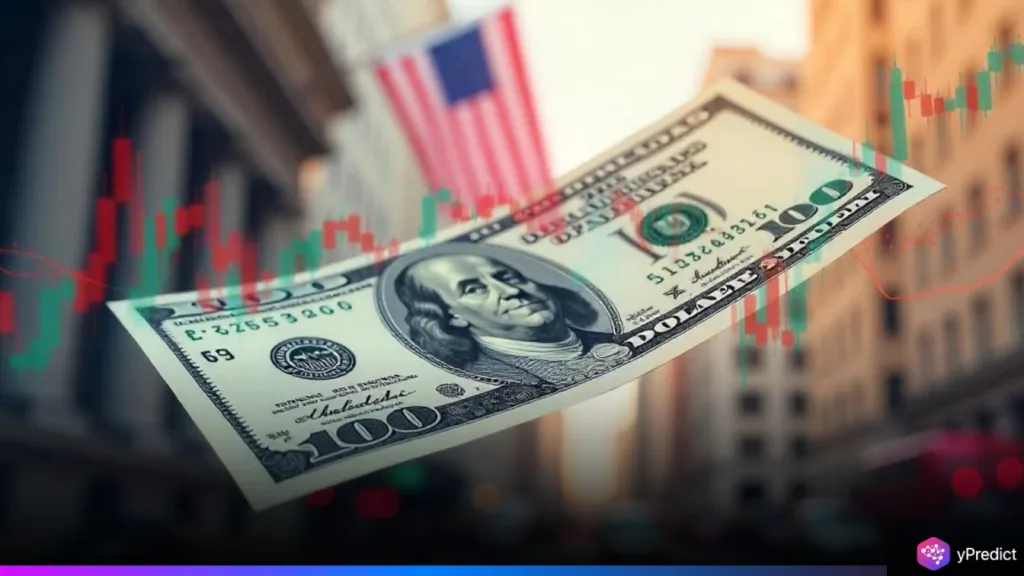
The U.S. dollar fell sharply on Monday after Moody’s Investors Service downgraded the nation’s long-term credit rating from Aaa to Aa1, citing rising fiscal deficits and long-term debt concerns. This marks Moody’s first downgrade of U.S. sovereign debt since 1994 and triggered immediate volatility in global markets. Treasury yields spiked, and investors moved toward safer assets. The downgrade intensifies focus on the government’s fiscal challenges amid looming budget debates in Congress.
Market Reactions to Moody’s US Credit Downgrade
The recent downgrade of the U.S. sovereign credit rating by Moody’s triggered immediate reverberations across global financial markets, fueling concerns over the country’s mounting debt and fiscal direction.
The US dollar fell against key currencies in early trading. It fell to ¥145.10 against the Japanese yen, a ten-day low, while the euro rose 0.73% to $1.1247. The United States Dollar Index (DXY) fell over 0.7%, reaching its lowest level in more than two weeks. Analysts at CBA’s Global Economic & Markets Research stated that, while the downgrading may provide short-term pressure on the dollar, the long-term impact on currency allocations is projected to be minimal, given comparable downgrades by Fitch in 2023 and S&P in 2011.
Emerging market currencies, including the Indian rupee, saw small advances. The rupee climbed to 85.40 per dollar, helped by the weaker US dollar.
Additionally, US Treasury yields soared. The benchmark 10-year yield increased by seven basis points to 4.55%, and the 30-year yield surpassed 5% for the first time since April 9. Investors seeking stability transferred their cash to conventional safe-haven assets, resulting in increases for gold, the Swiss franc, and the yen. George Lagarias, chief economist at Forvis Mazars, said,
What Moody’s sees, plain and simple, is that the ballooning debt is not being addressed. The Republican mega bill is also contributing to rising yields.
The equity markets also reacted sharply. U.S. market futures fell, with S&P 500 contracts down 1.2% after a five-day surge. European and Asian markets followed suit, weighed down further by disappointing economic data from China and escalating geopolitical rhetoric from the US administration aimed at important trading partners.
Moreover, the downgrading comes only days after the House Budget Committee approved a contentious tax-and-spending package that analysts predict will add $3-5 trillion to the federal debt over the next decade. When combined with the existing $36 trillion debt load, these events have raised worries about long-term budgetary sustainability.
Political Fallout and Economic Outlook
Market analysts emphasized that the U.S. credit downgrade highlights increasing concerns over Washington’s lack of fiscal discipline. While Moody’s acknowledges the nation’s economic resilience, it warned that rising debt levels now outweigh those strengths. Despite the downgrade, CBA analysts expect limited long-term impact on the dollar, citing past investor behavior. However, the loss of the AAA rating sends a strong message about America’s deteriorating fiscal outlook.
Moreover, investor uncertainty has grown amid the administration’s push for broad tax cuts and its combative trade stance, which led the EU to lower its growth forecasts. Companies like Diageo have warned of financial risks, with the drinks giant estimating up to $150 million in tariff-related impacts, though it plans to offset some costs through pricing and supply chain adjustments.
Conclusion
Moody’s downgrade of the U.S. credit rating underscores growing concerns over America’s fiscal trajectory. The downgrade has amplified market volatility, sparked a reassessment of U.S. asset risk, and revived global conversations about debt, growth, and financial stability
As markets absorb the impact, the pressure mounts on policymakers to address rising debt levels and restore investor confidence. The dollar’s decline and climbing Treasury yields reflect deeper unease about the long-term health of the U.S. economy.







